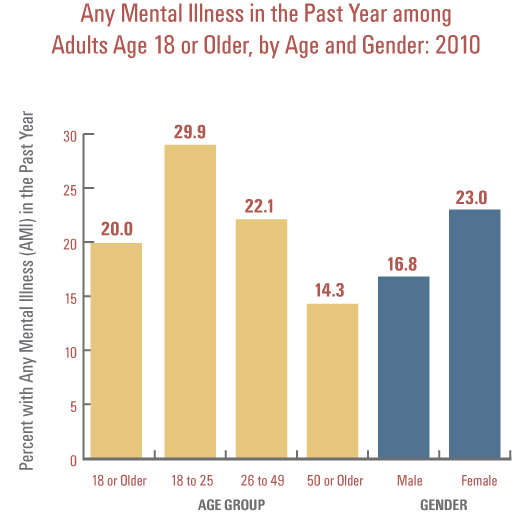
Study Finds
One in Five American Adults with Mental Illness
One in five adults age 18 and older in
2010 experienced mental illness in the
past year, affecting 45.9 million adults
across the United States, according to
a Substance Abuse and Mental Health
Services Administration (SAMHSA)
report released in January. The report
also found that 5.0 percent (11.4 million
adults) suffered from serious mental
illness. Adults experiencing mental illness
were more than three times as likely
to have met the criteria for substance
dependence or abuse in that period than
those who had not experienced mental
illness (20.0 percent versus 6.1 percent).
These findings were part of SAMHSA’s
2010 National Survey on Drug Use and
Health: Mental Health Findings, which
helps inform the health care community
about the need to reduce the impact of
mental illness on America’s communities.
The survey defined mental illness
among adults age 18 and older as having
had a diagnosable mental, behavioral,
or emotional disorder (excluding
developmental and substance use
disorders) in the past year. Serious mental
illness was defined as having mental
illness that was accompanied by severe
impairment in everyday functioning in the
past year.

Other findings from the survey showed
that the rate of mental illness was more
than twice as high among those age 18 to
25 (29.9 percent) than among those age
50 and older (14.3 percent), and adult
women were more likely than men to have
experienced mental illness in the past year
(23.0 percent versus 16.8 percent).
“Mental illnesses can be
managed successfully,
and people do recover,”
said SAMHSA
Administrator Pamela
S. Hyde, J.D. “Mental
illness is not an isolated
public health problem.
Cardiovascular disease,
diabetes, and obesity
often coexist with
mental illness, and
treatment of the mental
illness can reduce
the effects of these
disorders.”
The survey showed
that about 4 in 10
adults (39.2 percent)
experiencing any mental
illness in the past year received treatment.
The rate of treatment was 60.8 percent
for adults experiencing serious mental
illness. These findings illustrate the need
to continue efforts to increase access to
treatment and recovery support services.
The Affordable Care Act, signed into law
by President Obama in 2010, will help
32 million more people become eligible
for health coverage in the United States,
enabling access to mental health services.
Through its Prevention of Substance
Abuse and Mental Illness Strategic
Initiative, SAMHSA is working to assist
States, Territories, Tribal governments,
and communities to adopt evidencebased
mental health practices; deliver
health education related to prevention;
and establish effective policies, programs,
and infrastructure to help address these
problems. Throughout the Nation, new
programs are under way to strengthen the
capacity of communities to better serve the
needs of those suffering from mental illness.
Suicide is one area of focus. (See "Using Social Media to Save Lives.") Statistics
showed that 8.7 million adults had serious
thoughts of suicide in the past year.
Among them, 2.5 million made suicide
plans, and 1.1 million attempted suicide.
As part of its prevention efforts, SAMHSA
recently collaborated with Facebook and
the SAMHSA-funded National Suicide
Prevention Lifeline to connect people to
lifesaving services and curb the incidence
of suicide.
The survey was conducted by SAMHSA’s
Center for Behavioral Health Statistics
and Quality. The complete findings
are available on the SAMHSA Web
site. Hard
copies may be obtained by calling
1–877–SAMHSA–7 (1–877–726–4727).